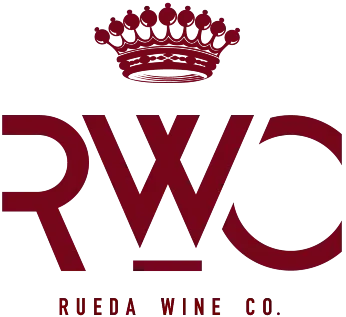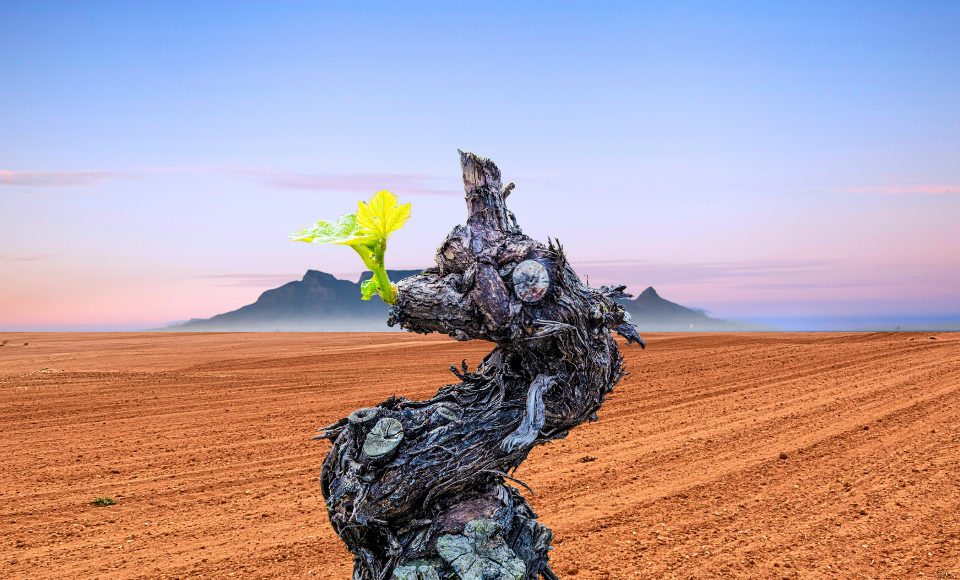
Perhaps the most widely cultivated and versatile grape, Chenin Blanc, hails from the banks of the Loire River in the Loire Valley, France. Also called Steen and Pineau de la Loire, among other names, it is a grape that has circumnavigated the globe. France and South Africa are the two countries most famous for elevating Chenin Blanc wine. Today, we see winemakers in California, Mexico, Argentina, New Zealand, Australia and many more regions that have taken to producing sumptuous single varietals and blends from this multifaceted grape.
As Chenin Blanc was first cultivated in France, let us begin there. And, much as this adaptable grape did, we will chart a course across oceans and time. How did it adjust to the challenges of new regions and climes? And what rewards did it lavish on its cultivators?
The Loire Valley
The silty banks of the Loire River, rich in minerals, created a lush soil for growing Chenin Blanc. The cool, temperate region is famous for many appellations: Anjou, Savennieres, Quarts de Chaume, Vouvray, Bonnezeaux, and Montlouis. Many of the vineyards there are hundreds of years old, but the genesis of the Chenin Blanc grape is still a contentious issue among wine historians.
Two major schools differ on the birthplace of the grape. Most will say that Loire Valley is its home, but some name Montchenin as the first region to record the grape in the 15th century. However, one of RWC’s producers, Domaine de la Couleé de Serrant of Nicolas and Virginie Joly, has an unbroken 893 consecutive vintages on the banks of the Loire. La Couleé de Serrant’s first recorded vintage in 1130 in the Loire Valley is among the first recordings of a Chenin Blanc planting in this region.
A slightly earlier recording arises from an often-cited essay written in 845 by Charles le Chauve. This essay mentions a “Plant d’Anjou” that was given to Saint-Maur de Glanfeuil Abbey in the Loire Valley. Historians believe it is possible this was Chenin Blanc. Perhaps the Chenin Blanc sowing in Montchenin and later replanting in the Loire was a mix-up of names rather than grapes.
We see a similar phenomenon with the Agudelo varietal in Galicia. Once considered a distinct varietal but since tested and confirmed as a genetic twin of Chenin Blanc. Much like the Loire-Montchenin disagreement, how the grape travelled there and who was the first to bring it to Spain is another disputed matter among historians.
Why is Loire Chenin Different?
The combination of river, land, and valley united with the cool but not-frigid climate results in a singularly special environment for growing Chenin. One that would be impossible to replicate anywhere else.
The Loire is the longest-flowing river in France. Before it converges with the Atlantic, we find the Loire Valley – and most of the vintners producing Chenin Blanc. This valley tends to be cool to moderate and can suffer from winter frosts. As the Chenin grape is so versatile, we can see drastic style differences depending on the appellation and the amount of time it’s left on the vine.
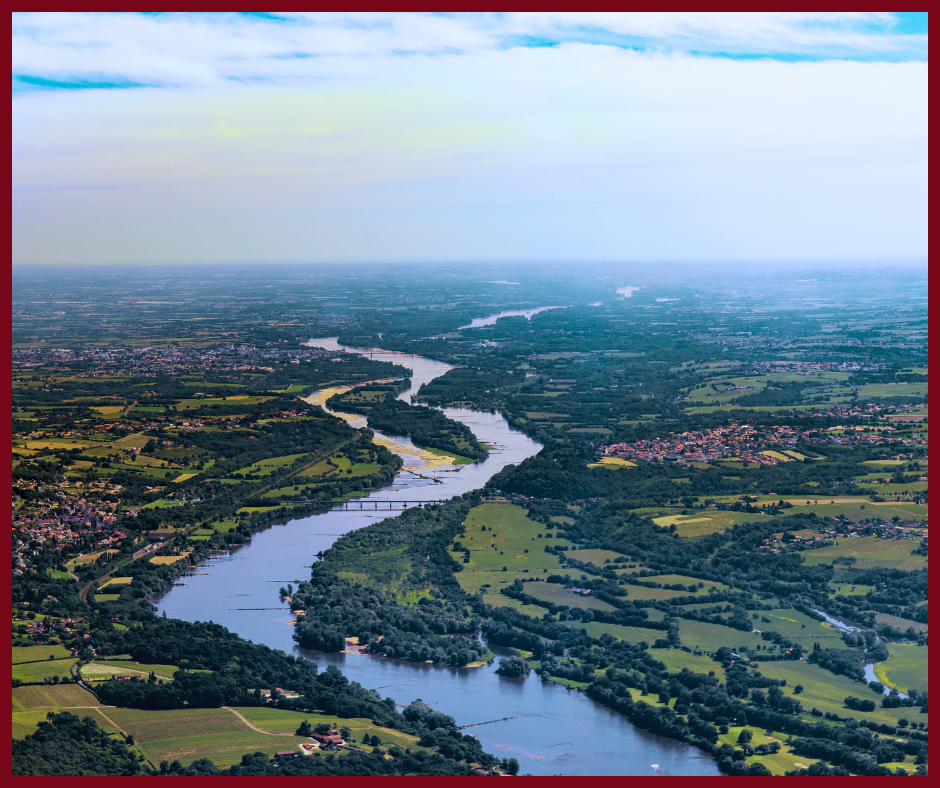
Image: View of the Loire Valley in Nantes, France
A terroir as distinct as the Loire is reflected in these French Chenin Blancs. The soil of Central and Western France is imbued with alluvial minerals and luxurious clays that the Chenin grape expresses keenly.
The wine is crisper here, reflecting apples, pears, stone fruits, and even, rarely, limes. There is a huge variety of Chenin in the Loire. From dry, semi-dry, semi-sweet, and sweet dessert wines and even sparkling creations, Chenin is articulated and celebrated with every colour on the winemaker’s palette.
The grape’s acidity often tends to be very strong. It therefore demands various winemaking processes to curb its effect and prevent or soften the expression of tart notes. This can be achieved through many mechanisms: ageing, blending, oaking, malolactic fermentation, or the addition of sugars during fermentation. Curtailing acidity is a necessity, but it’s also one of the many reasons why Loire Chenin ages so well.
The growth cycle of Chenin Blanc in this region also drastically shapes this wine’s expression. Chenin Blanc buds early in the Loire and must be protected from frost. However, the grape itself can be picked many times during the growing and post-growing season. These harvesting options allow producers to highlight and choose between different levels of acidity, dryness, and sugars.
The Sweeter Side of Chenin
In the Loire, one can find producers making Chenin wines with Botrytis. This ‘soft rot’ or Noble Rot is a type of fungus that adds aroma and intensity to a wine, not dissimilar from the use of fungus in Roquefort or Gorgonzola cheeses. These misty bacteria only come from harvesting grapes that have been exposed in the late harvesting season and can add an intricate layer of complexity.
Noble Rot’s emergence is not always assured, which is why it is so celebrated when it occurs. Besides desiccating the grape, which distils the sugary juices into something approaching syrup, Noble Rot conveys new notes and intensifies existing flavours. It can mature notes of honey, apricot, and caramel and even impart new ones like ginger. It’s no wonder botrytised dessert wines are considered transcendent.
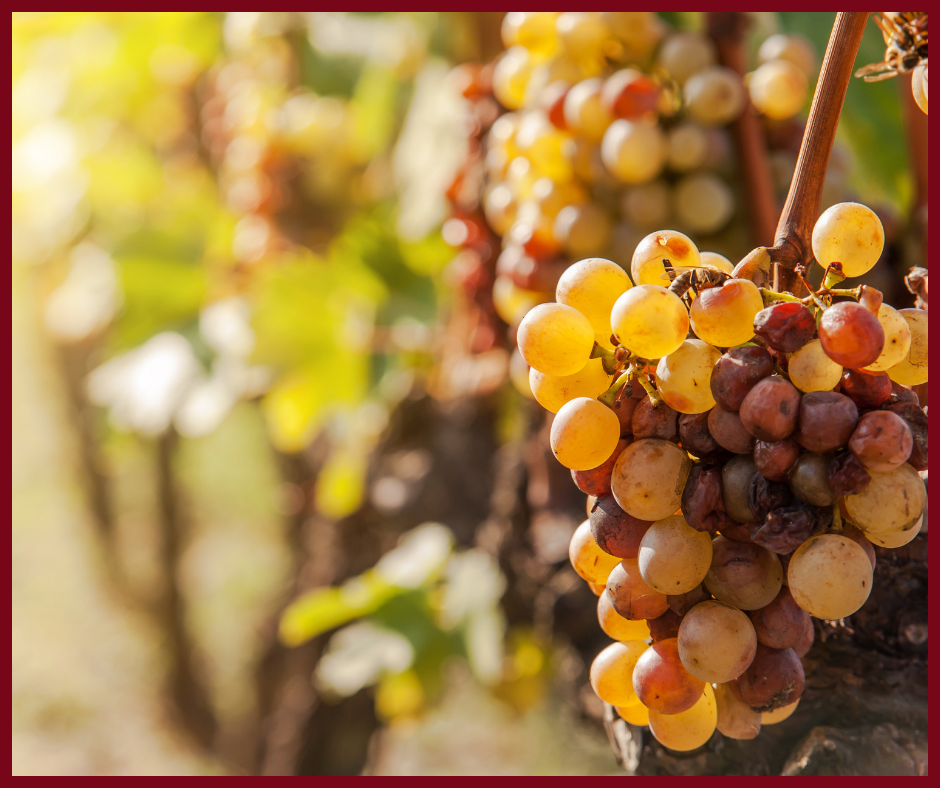
Image: Noble rot on Chenin Blanc grapes
The high acidity of Chenin allows for this deep concentration of sugars. We can therefore find a breadth of Chenin Blancs that are not only dry, but sweet dessert, or even botrytised style wines. As always the terroir plays a pivotal role here. The clay-heavy soils in the Loire Valley allow for this transference of flavours that underpin and ground the sweetness of the botrytis style.
These sweeter wines have incredible ageing potential, with the well-crafted Loire Chenin Blancs regularly boasting 100-year ageing potential. And again, the Chenin Blanc wine demonstrates incredible versatility here. The flavours transform from green fruits to richer, nuttier piquancy, gaining stunning complexity with age.
From the Old World to the New
Jan Van Riebeeck was the first person to plant Chenin in South Africa. On the 2nd of February 1659, the first grapes were pressed and South Africa had its first wine produced after the initial planting of three varietals in 1656. Famously, Jan van Riebeeck wrote in his diary after his first sip of the first South African wine grown in the Company Gardens: “Today, praise be to God, wine was made from Cape grapes.”
Originally called ‘Steen’ in South Africa, the grape was rechristened Chenin Blanc in 1963 after a leaf comparison by the lineage of the varietal was established by Professor C.J Orffer of the University of Stellenbosch – which cleared any previous doubt. It is the principal grape variety in South Africa and accounts for 20% of all grape production. At times, Chenin has been as high as one-third of all grapes produced in a single season.
Not only is Chenin the primary grape planted in South Africa, but South Africa boasts the largest planting of Chenin Blanc globally. Stellenbosch, Paarl, and the Swartland are the most famous regions, but it can also be found further afield.
In France, it is normally vinified as a single varietal. However, in South Africa, it is often blended with Chardonnay, Viognier, or Colombard. Though single varietal Chenin has seen a recent resurgence in popularity.
A New World, a New Climate, a New Expression
Regional temperature and terroir greatly affect the expression of the Chenin Blanc grape. Compared to the Loire Valley, the warm South African climate elicits a completely different palate. South Africa has long, dry summers that require irrigation. In France, there are bitter, rain-blighted winters and muggy summers. By law, no artificial irrigation may occur in France.
Colder climes tend to lighten the taste and favour, honing the acidity to reflect apples or tangier, green fruits. Warmer regions allow for the articulation of more succulent fruit notes. Many producers observe essences like peaches, citrus fruits, quince, and even mango or pineapple. Chenin’s versatility continues into the cellar, where it can be oaked or unoaked. An oaked Chenin Blanc wine will be more buttery, reflecting a soul more akin to Chardonnay.
But, the manifestations of Chenin Blanc are affected by more than just climate. It can be harvested late, as that abundance of acidity allows for the further transformation of flavours. However, Chenin Blanc is a very productive, fertile grape that if well watered and fertilised, provides large yields. It is this fertility that can be its downfall if the vigour of the vine is not carefully controlled.
The Vine Itself
Constraining vine vigour is achieved primarily through two mechanisms: pruning and vine age. Pruning is the first method, a great art in and of itself and one not easily mastered. This process of removing shoots, leaves, and lateral growth is often done during the winter. This curtails the yield of a vine and concentrates its flavour.
Vine age, that is, the subtle changes in the vines as they age, has remarkable effects on the wines produced from those grapes. With Chenin, astonishingly expressive as it is, we see huge complexity coming from older vines. There isn’t consensus, or at least legal requirements for what can be termed ‘Old Vine,’ but generally, these are vines that are fifty years or older.
In South Africa, the Old Vine Project (OVP) has been established to celebrate, protect, and certify these old vine wines. To earn the designation the wine must originate from vines surpassing thirty-five years in age. The OVP recognises that there is a distinct difference in the quality of wines made from grapes grown on old vines. The Project aims to engender a culture of excellence in vine stewardship. At the heart of the organisation is a veneration of vineyard heritage.
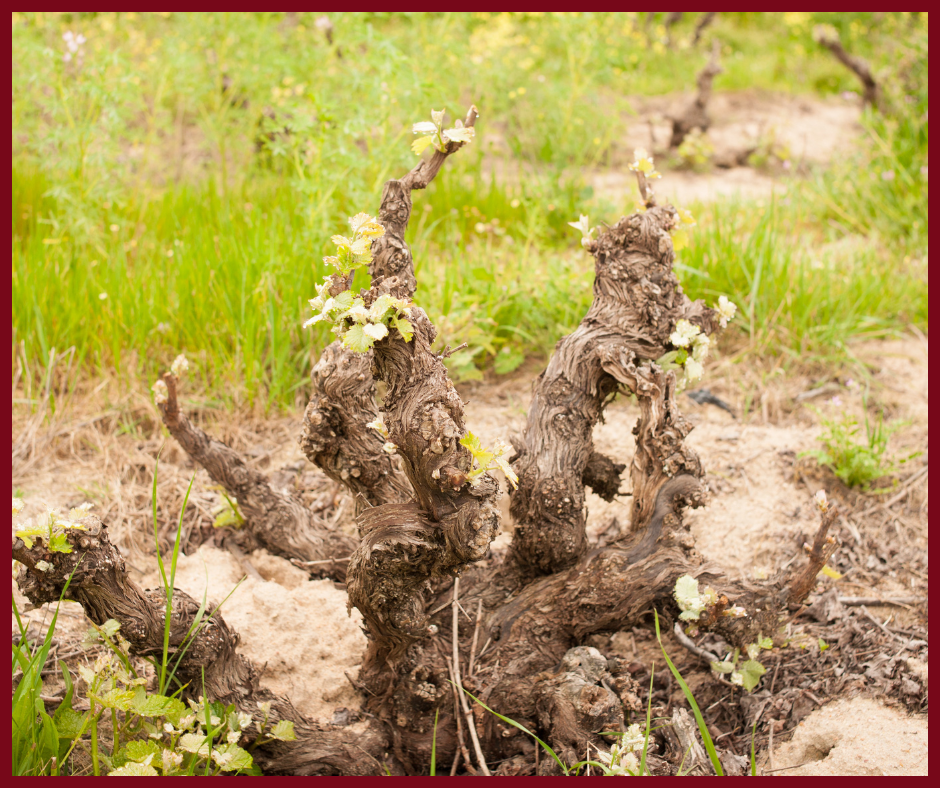
Image: Old bush vines in the Swartland
Younger vines tend to produce more fruit. In short, the flavour, aroma, sugar, and acid are more diluted. They are also susceptible to over-production. In extreme cases, young vines can yield flat, tasteless grapes direly bereft of sugars and entirely unsuitable for wine production.
Old vines, conversely produce much less fruit, which results in more nutrition from the soil reaching the individual grapes. If the vines don’t overproduce, the growers can more carefully control direct sunlight on the individual fruits. Canopy, vine growth, and the speed of ripening can be manipulated more adroitly in older vines. Even how the minerals of the soil and the character of the terroir are conveyed to the grapes can be controlled more completely than younger vines.
The complexity of flavour imparted to grapes by older vines tends to favour longer ageing, and the wines produced on old vines benefit greatly from it. Certain Old Vine Montlouis, Saviennieres, and Anjous in the Loire are said to be capable of up to 100 years of ageing (or even more!).
The Vinification Process
As has been previously noted in our discussion of the Nebbiolo grape, there are sometimes immense challenges (and rewards) to working with highly acidic grapes. With Chenin Blanc wines, malolactic fermentation (MLF) is the process used most often to ameliorate acidity. It is a process of acid conversion achieved by adding bacteria after the first fermentation. Specifically, malic acid is converted to lactic acid by adding various bacterium. MLF often occurs in wines aged in non-virgin oak barrels because Oenococcus Oeni, Pediococcus, and Lactobacillus bacterium, the key bacteria used in MLF, congregate there. MLF is often used in red wine production; however, high-acid white wines benefit from MLF.
Primarily, MLF lowers acidity in wine but is also responsible for the transformation of mouth-feel by ‘butterfying’ the wine, developing the aroma, softening the tarter flavours, and generally smoothing the wine. This non-yeast ‘secondary’ fermentation must be carefully controlled as too much addition of diacetyl, a by-product of the acid conversion, can overpower the lighter flavours and more floral notes. Many South African producers use MLF in their blended whites and single-varietal Chenins. Conversely, keeping the acid levels high through certain maceration styles like ‘skin contact’ will see Montlouis, Saviennieres, and Anjous capable of lengthy ageing
The Regional Differences in South African Chenin Blanc Wine
South Africa is blessed with many different regions suitable for growing grapes. For Chenin, three significant and distinct regions stand out. The Stellenbosch region is the historic home to many vineyards and grape varieties, including Chenin, with the Swartland and West Coast regions also offering favourable climactic conditions for growing Chenin.
Because Chenin Blanc has a longer harvesting time and can be a terroir-expressive grape, the wines produced in these three regions can have vastly different influences. These differences change the way the grapes are formed and ultimately impact the style of Chenin in your glass.
Chenin from Stellenbosch
Stellenbosch is the oldest settlement in South Africa, after Cape Town. It has long been one of the historic homes of South African wine. Winemaking and viticulture culture took root in earnest with the arrival of the French Huguenots in the 1690s. The Huguenots revolutionised viticulture and winemaking practices in the Cape. Today, Stellenbosch is home to more than one-fifth of all vines planted in South Africa.
With such a deep and proud history, there is very little doubt that the Chenins of this region display their own, unique characteristics.
The Cape Fold Mountains encircle the town of Stellenbosch. These mountains were formed during the Paleozoic age, roughly 541-252 million years ago. Sandstone and shale are commonly found in this formation. However, in areas where there has been more erosion, sandstone as well as granite are exposed. These soils also contain clay, giving the soils both free-draining and water-retaining properties.
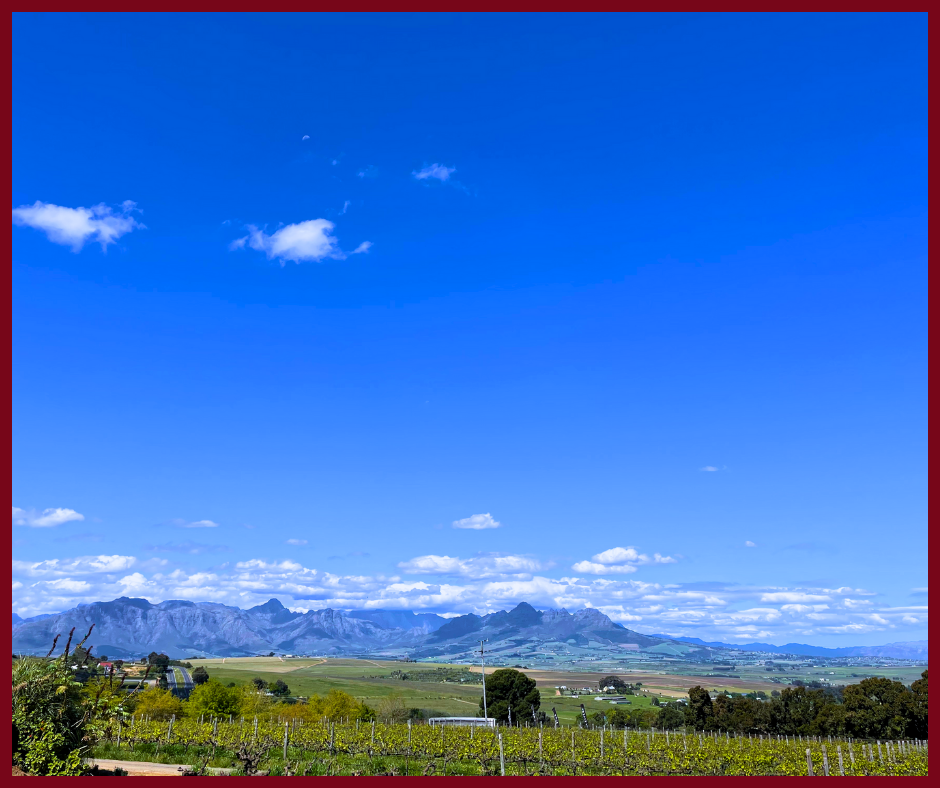
Image: View of the Stellenbosch Mountains from the Karibib vineyards on the Polkadraai Hills
This mountainous terrain provides variation for the wine farmers of Stellenbosch. With differences in altitude, slope steepness and slope orientation, it is easy to understand why this region is perfect for viticulture. Due to its proximity to the ocean and the steep slopes, this region also receives high rainfall. The high levels of rainfall mean that little to no irrigation is necessary.
The Stellenbosch region is afforded the cooling influence of sea breezes coming off of False Bay. The infamously strong south-easterly also helps cool this region. This results in wines that are often ripe with clean and cut freshness.
With its deep history and steep slopes, Stellenbosch is understandably divided into wards. The official wards include:
- Polkadraai Hills
- Bottelary
- Heldeberg
- Banghoek
- Devon Valley
- Jonkershoek Valley
- Simonsberg-Stellenbosch
- Papegaaiberg
- Vlottenburg
The Faure, Helderberg, Stellenbosch Mountain and Upper Blaauwklippen Road are, however, unofficial wards.
Chenin From the Swartland
In the Swartland region, many vineyards are slightly further inland relative to the vineyards of Stellenbosch. These vineyards are exposed to a sliver of coast along the Atlantic Ocean. The conditions of this region, although Mediterranean-like, are tougher and dryer than Stellenbosch. However, despite these trying conditions, this region is home to approximately 15% of the country’s Chenin Blanc plantings.
The Swartland is well-known for its incredible dryland bush vines and old vines. With the highest concentration of South Africa’s old vines, the Swartland boasts large numbers of Chenin Blanc and Cinsault old vines. Their ages range from 35 years to some that are over a century old – think the Sadie Family t’Voetpad, a co-planted vineyard of Chenin Blanc, Palamino, Semillon Blanc and Semillon Gris and Muscat d’Alexandrie. Old vines have a lower yield per vine, concentrating the flavour and delicately expressing the underlying terroir.
Classified as a coastal region, the Swartland receives predominantly winter rainfall. Summers are warm and arid but are somewhat moderated by cold breezes of the Atlantic’s Benguela current. This region has a wide diurnal range, which means sugars can develop during the warm daytime. The cold nighttime temperatures preserve the fruit’s freshness, acidity, and aroma. Due to these harsher conditions, dryland farming has been essential for the resilience of vines hoping to grow in this region.
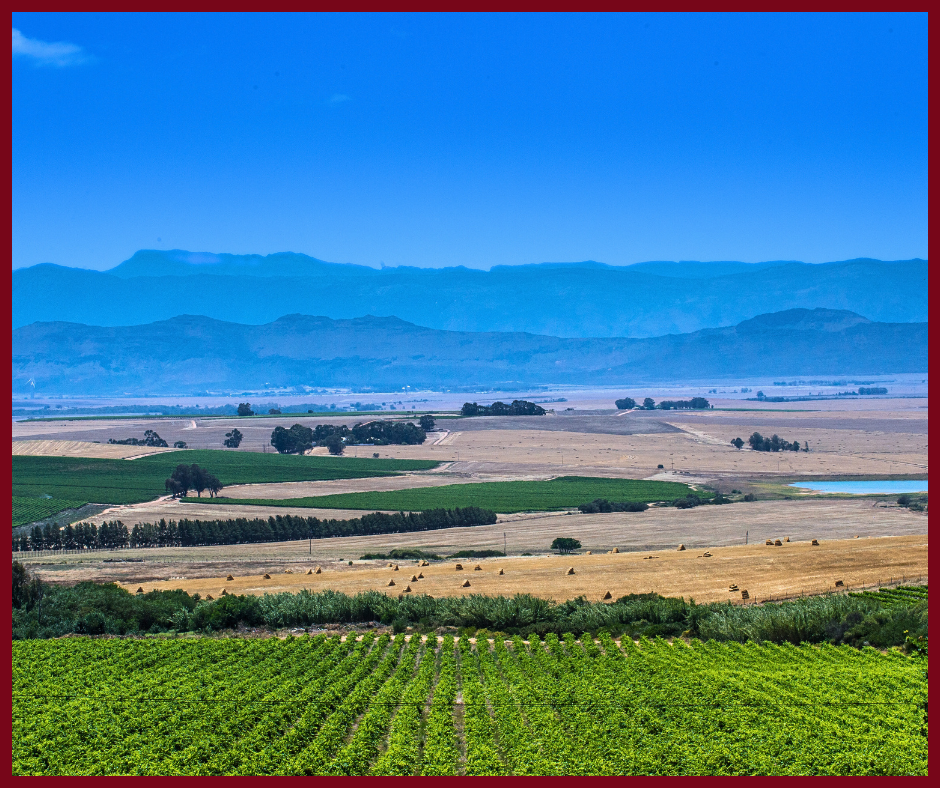
Image: Swartland vineyards with the backdrop of Riebeek Kasteel West
These hot and dry growing conditions mean that Chenin Blanc grapes are less susceptible to fungal diseases. The dry conditions lead to lower yields per vine, and more concentrated fruit.
The soil of the Swartland region is part of the Malmesbury group shales, Table Mountain sandstone, and soils derived from Cape granite intrusions. The Malmesbury group of shales is one of the oldest formations and includes shale, phyllite, schist and greywacke. Swartland Chenins therefore offer an example of viticulture practiced on some of the oldest soil materials in the world.
Samantha Suddons of VineVenom, while speaking to Wines of South Africa, characterised Swartland Chenin as a, “…a chameleon for terroir – the old vines show such intense personality that makes it possible to differentiate not just the different soil types of the Swartland within the wines, but even the different exposures and valleys of a small area, such as the Paardeberg.”.
The wines of the Swartland offer a unique Chenin experience, with a concentration of flavour, especially with old vines, and a clear minerality reflecting the deep-rooted history of the underlying soils.
The Swartland is divided into several official and unofficial wards. The official wards of the Swartland region include:
- Malmesbury
- Paardeberg/Perdeberg
- Paardeberg South
- Piketberg
- Porseleinberg
- Riebeekberg
- Riebeeksrivier
Chenin From the West Coast
The West Coast and Swartland regions share many of the same characteristics. They are both hot and arid and run along the Atlantic Ocean’s coast. The West Coast is defined by the broad 145km valley of the Olifants River region, which encompasses a large swathe of land north of the Swartland. Despite its high temperatures, viticulture has taken place in this region as early as the 1700s. Chenin Blanc thrives here and is the most widely planted white variety in this region.
Areas within the West Coast such as Piekenierskloof and the Cederberg are home to some of the highest-altitude vineyards in South Africa. These high-altitude climates make for great organic growing conditions. Vineyards in these regions reach higher daytime temperatures than those in the lower valley areas. As with the Swartland region, the West Coast has a wide diurnal range and is benefited by the cool Atlantic breezes.
The otherwise dry and arid West Coast region is brought to life by the Olifants River. The surrounding areas are characterised by loamy, sandy and fertile alluvial soils. These sandy alluvial soils are also part of the Table Mountain sandstone mountain group of the Swartland. The dominant soils in this area include Dundee, Hutton, Clovelly, and Glenrosa. These granite-derived soils lend acidity and can retain water well.
Further north, in the Lutzville Valley, Koekenaap, Bamboes Bay, Spuitdrift and Vredendal areas, there is significantly less rainfall. However, the soil surrounding the Olifants River is highly fertile in this region. These soils have a rich viticultural foundation, although irrigation is essential in this dry climate. Geographically, this northern section is closer to the Atlantic, allowing the cool sea breeze to slow the grapes’s ripening process.
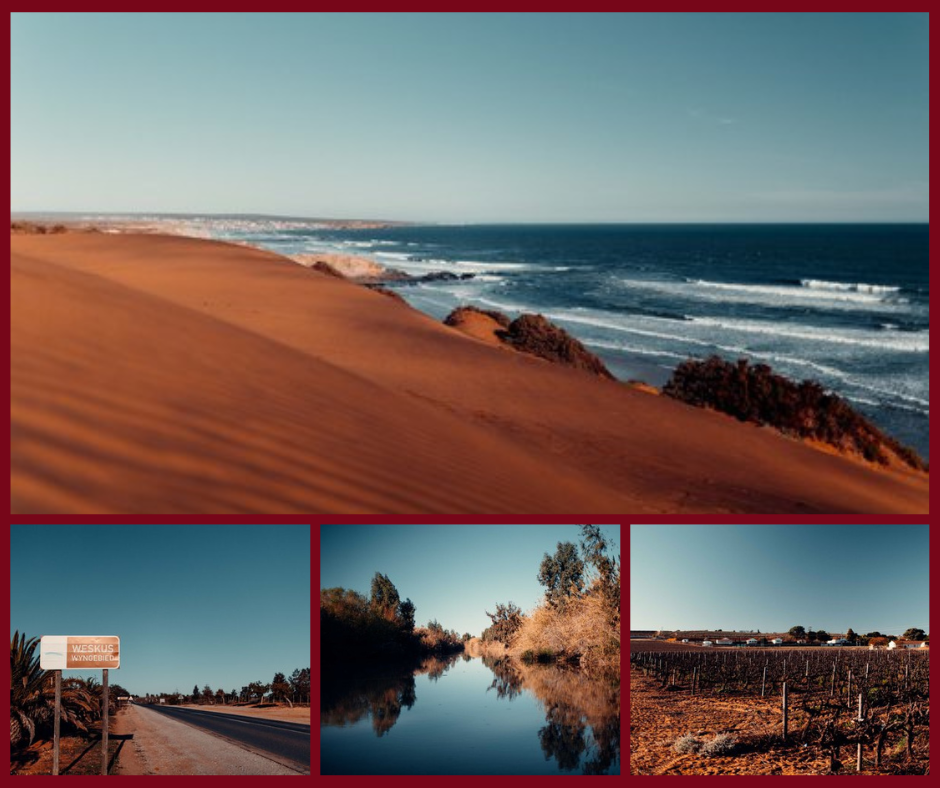
Image: Collection of images from Sakkie Mouton Family Wines, depicting the unique conditions of the West Coast
The styles of wines produced in this region can vary widely. However, their acidity usually comes from picking earlier rather than relying purely on the sea breeze influence. These wines can often be lower in alcohol to preserve their natural acidity and crispness. Chenins from this region may be described as herbaceous, for their light-bodied greener flavours.
The Olifants River region includes:
- The Citrusal Mountains
- Piekenierskloof
- Citrusdal Valley
- Lutzville Valley
- Koekenaap
- Vredendal
- Bamboes Bay
- Cederberg
- Spruitdrift
The Very Best of Chenin Blanc Wine
At Rueda Wine Co. we proudly represent some wonderful French and South African Wine Producers and their world-class wines. From true paragons of the Loire River Valley to the disruptors of the Oldest New World Wine region, we have exemplars of every style and method of Chenin Blanc wine. Enjoy some of the best, ranging from dry to sweet and including sparkling. One should expect the Loire wines to be more mineral-laded and accented by the essences of stonefruit and honey. These will have the best ageing potential and would do well in our cellars or your own.
In the Loire
Francois Chidaine is considered by many to be one of the grandmasters of dry Chenin. In Montlouis-sur-Loire, in the centre of the Touraine, where only Chenin grapes may be planted by law, nearly fifty hectares are dedicated to the mastery of Chenin. The terroir expresses and reflects a ballet of minerals: clay, limestone, chalk, and white limestone rocks. 620L oak barrels are the crucible for alcoholic fermentation, followed by twelve months of bottle ageing.
Otherwise, look to La Coulée de Serrant of Nicolas and Virginie Joly for some spine-tingling wines. Considered one of the most important vineyards and wines to exist. This estate boasts unparalleled history and equally high-quality wine.
In South Africa
Among our South African collection, we have producers that highlight the very best of three famous Chenin Blanc terroirs. Look to Ian Naude for a quintessential example of an Old Vine South African Chenin Blanc or Angus Paul for exciting, game-changing Stellenbosch Chenin. It has incredible ageing potential of twenty or more years and boasts layered notes of both pineapple and crunchy green apple, the interplay of which displays the uniqueness of Stellenbosch.
Among the West Coast producers, we see Sakkie Mouton. Sakkie is a true maverick. He brings a novel perspective to many blends. And experiments with an array of exceptional varieties and wines. Sakkie believes in letting the product speak for itself and always highlights the grape and the vineyard as the stars of the show.
In the Swartland again we find Ian Naude Family Wines and Tim Hillock Wines. At thirty-four years old, Tim Hillock’s La Cosmica Chenin Blanc vineyard is on the verge of Old Vine status. Its startling complexity and nuanced flavours demonstrate its sophistication. And the duet of peach and pear capture the heart of the Kasteelberg Mountains.
From the Old World to the New
It’s not often that a wine originating in France can be challenged by the same varietal from a different region. However, when it comes to South African Chenin Blanc wines, the proof is in the bottle. With hundreds of international and domestic accolades, South African Chenin Blancs are a varietal that can compete internationally. Any true wine lover should endeavour to try the very best Chenins from both regions. Decide for yourself who is worthy of the title of best Chenin Blanc producer in the world.
À votre santé!
Written By: Rhett Sinnema
Contributing Writer: Christina Botha
Fact Checked By: Christina Botha and Fernando Rueda
Edited By: Fernando Rueda
